|


 You don't need to buy a lot of toys for your child, but you probably will, regardless of your income level. On birthdays and holidays most children are given large numbers of toys with warm and loving enthusiasm from parents and relatives who enjoy giving them. Since you and they are going to spend the money anyway, why not buy toys that your child will like and that won't break when they're played with? You don't need to buy a lot of toys for your child, but you probably will, regardless of your income level. On birthdays and holidays most children are given large numbers of toys with warm and loving enthusiasm from parents and relatives who enjoy giving them. Since you and they are going to spend the money anyway, why not buy toys that your child will like and that won't break when they're played with?
The recommendations in this chapter, which can help you with your selections, may often seem advanced for the stages that supertots go through; but children get more out of toys they grow into than toys that arrive too late to be challenging.
If you do buy a toy that seems too advanced for your child, don't force him or her to use it in any particular way. If it's a slide, for example, don't demand sliding; when your child is ready, he or she will learn to slide. For now, the slide can be a slope to roll balls down and a place to crawl under.
Toys for a one-year-old
A simple-to-work,
safe jack-in-the-box
The box should open easily enough for your child to do it alone.

Stacking Rings
Your child won't be able to stack the rings in the correct order until he or she
is two and a half or three; but now he or she will like to hold them,
throw them, teethe on them, and watch older kids and parents stack them
correctly.

Snap-lock Beads
These colorful, plastic beads are pretty and fun to hold.
One-year-olds can't snap them yet, but they like to pull them apart and throw them about.
Indoor Slide
Many parents think indoor slide and gym houses are worth it because they interest
children for several years. In the long run they provide more pleasure than $50 worth of small,
cheap toys that get lost or fall apart. Children can learn to slide when
they're fourteen to eighteen months old.
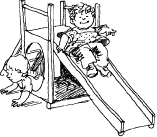
Small House and People
A toy house seems to cost a lot at first, but then after it has lasted so long, it turns out to be a good
bargain. These toys come with cars, little play people, furniture, and other props.
You can purchase only
the
people
and furniture
in smaller, much less expensive packages,
and improvise a house or apartment
out of a cardboard box.
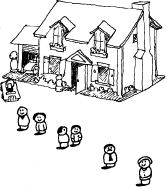
Toy Telephone
Supertots like to imitate their parents on the phone.

Small Riding Toy
Choose a small, stable, safe, and easy to ride.
Children learn to ride it when they're fourteen to eighteen months old.
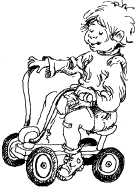
Toys for a one-and-a-half-year-old
Shape Toys
Children enjoy putting three-dimensional shapes into something (a special "mailbox," toy shoe, or box)
into which matching holes have been cut. They take the shapes out and put them in again - a perfectly
satisfying activity as long as the shapes aren't too difficult.
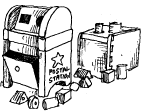
Teddy Bear
A one-and-a-half-year-old can begin to develop an emotional attachment to a teddy bear. Be sure the bear is safe and well made; it may get a lot of wear. The eyes and nose should be embroidered on securely; there should be no buttons to chew off and swallow. Don't buy a wind-up, musical teddy bear; it's not as cuddly, and any small mechanism could come out and get swallowed.
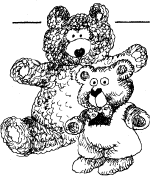
Big Wooden Beads
Fat, easy-to-hold beads are fun to hold and drop into containers.
An older child or adult has to help with the stringing.
A Big, Simple Dump Truck
A one-and-a-half-year-old should be able to fill the truck and dump it easily.
Don't buy a dumptruck that has a lot of little plastic parts that break
off easily.

Play-Doh
Play-Doh, a nontoxic modeling clay, can be reused if you store it in airtight jars. Kids like Play-Doh
because it's soft. Parents like it because it's less messy than regular clay.
Some people prefer real clay.
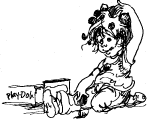
Barn and Farm Animals
Children like animals and enjoy putting small, realistic ones into a barn or box.
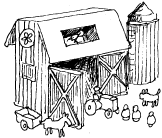
Alphabet or Number Blocks
Young children like these cubic, hand-sized blocks for stacking and dropping into containers.
You may like the letters, but don't expect your supertot to do much more than recognize a few of them.
Spelling comes later.
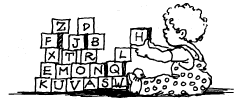
Push-and-Pull Toys
Supertots like to push and pull this kind of toy around,
especially if it makes a noise.
Sometimes they pretend the toy is a vacuum cleaner or lawnmower.
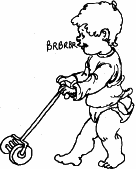
Toys for a two-year-old
Safe riding toy
One of the most fun and safest riding toys is a motorcycle. Kids push it with their feet,
steer easily, and rarely fall off.
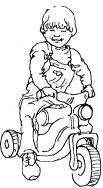
Cobbler's bench
Supertots pound the pegs through to the other side, then turn the bench over and pound them back.

Castle
A play castle often includes a trap door, secret room, and drawbridge. These can fascinate children from one to nine. Since older kids like this toy, it's a good one to bring out when they come to visit. The castle may come with a royal family, horses, dragon, and knight in shining armor as well as some royal furniture.
Art supplies
See Chapter 6.
Doll
Both girls and boys need dolls to love; and fortunately, for little boys, toy companies have
come out with dolls that actually look like real boys.

Small Cars and Trucks
Buy safe ones that have plates attached underneath so you can't see the axles, which are small and
could be dangerous if removed and swallowed. Little Matchbox and Corgi cars are well designed,
inexpensive, and long-lasting.
Single-shape puzzles
Each piece is one thing to look at. Each piece has a little handle.
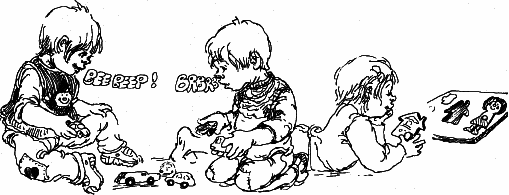
Toys for a two-and-a-half-year-old
A Set of Big Wooden Blocks
A good set of hardwood blocks will last for years and offset in hours of pleasure the initial cost.
Supertots like to make towers, castles, cities, roads, tunnels, houses, forts, and farms out of the blocks.
And there's nothing like wood; plastic, foam, and cardboard blocks just don't make it.
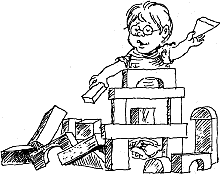
Tea Set
Buy a safe aluminum or plastic tea set and keep it on a special shelf in the kitchen or dining room
so that your child can cook, serve, and do dishes along with you.
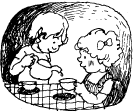
Punching Toy
A big, soft, inflatable, heavy-duty plastic punching bag is a good toy for channeling aggression and anger.
You can teach your child: You mustn't hit me, but you can hit the punching bag all you want.
A Set of Different Hats
Supertots love different hats: a fireman's hat, a policewoman's hat, a cowgirl's hat, a train conductor's hat,
a dressy hat. Keep them all together in a special box that you open for parades and parties.

Easy Wooden Puzzles
These puzzles should be easy enough for your child to do alone after you have
helped a few times. There should be no more than eight easy pieces at this stage. Store the puzzles in
a special place when they are not being used; teach your child to put each finished puzzle away before
taking out a new one, so pieces won't get lost.

Train
A small nonelectric toy train that can be hitched up and moved around easily is a fine toy for a supertot.
Check ahead of time to see if your child can hitch it up and unhitch it without your help, and that it
doesn't become unhitched when your child moves it around.

Toys for three-year-olds
Construction Trucks
Good, sturdy construction trucks that work with real sand and dirt give
children hours of pleasure.
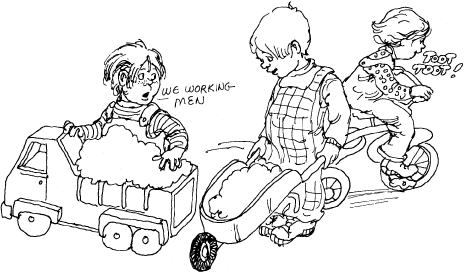
Tricycle
Most three-year-olds can learn to pedal by themselves.
Wheelbarrow
Supertots can use a toy wheelbarrow to transport dirt, stones, dolls, and other toys.
They like to feel they are "working."
Finger Puppets
Little puppets that fit on fingers encourage dramatic play, an activity three-year-olds enjoy.
Fisher-Price Play Family figures can be used as finger puppets.
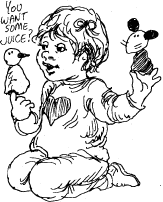
Tools
You can buy toy tools in a fancy tool kit or with a toy tool bench, but you don't need to.
The tools are usually a thrill in themselves, and supertots use them to "fix things" around the house.
Often the toy bench is ignored.
Simple Lotto Games
Lotto, an inexpensive card game in which you match pictures, has many variations;
check to be sure the ones you are buying will be easy enough for your child to enjoy.
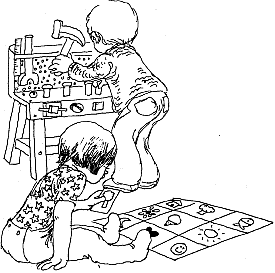
Good buys at the dollar store
There's a lot of junk at the dollar store - toys that fall apart and have unsafe pieces that children can
accidentally swallow. Since you'll probably buy toys in the dollar store often, develop an eye for the
good buys you can usually find there:
• Safe little cars
• Bubble-blowing liquid
• Small, adult-looking dolls (Tarzan, Batman, etc.)
• Magic Slate (the thing you write on and erase by
lifting up the plastic page)
• Fat crayons
• Balls of all sizes
• Blunt-pointed scissors
• Paint-with-water books
• Golden Press books
• Play-Doh
• Shovel and pail
• Big plastic trucks and cars (some are better than others; find the safe, simple ones)
• Small plastic figures (they come in plastic bags;
you can get cowboys and Indians, firemen, soldiers, etc.)
The toys you buy should:
• be too large to be swallowed
• have no detachable parts that can be swallowed
• have no little parts that can break off and be accidentally swallowed
• have no sharp edges or points be well made
• not be made of glass or brittle plastic
• be nontoxic
• have no parts that can pinch fingers or catch hair
• have no long cords that could accidentally
strangle a young child
Toy storage
Instead of throwing all of your child's toys into a huge toy box at the end of a hectic day, it makes sense,
if you can stand it, to sort them out and store them away for future, organized use. Keep similar toys
together: little cars in a shoe box, dolls and doll clothes
in another box, snap-lock beads in a tin can,
lacing beads in another can, and so on. Bring out only a few toys at a time, and when interest in these toys
diminishes, put them away before you bring out others. The purpose of all this is not to be compulsive,
just to make the toys more enjoyable. A toy box filled with all sorts of toys mixed together is not much fu
n because it's too confusing. The contents beg to be thrown all over the room in order to be seen.
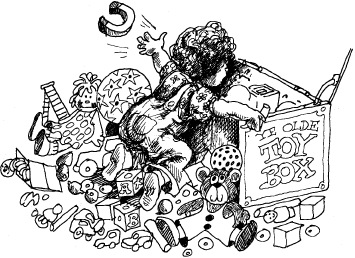
CLICK here for Chapter Six: Art Activities
|

